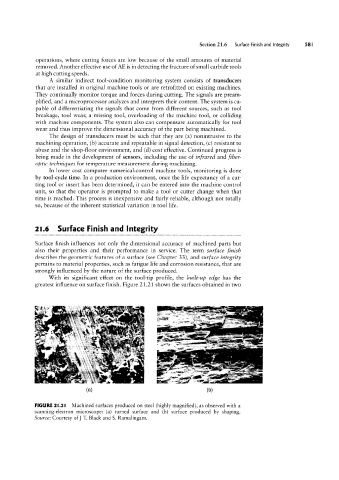Page 600 - 04. Subyek Engineering Materials - Manufacturing, Engineering and Technology SI 6th Edition - Serope Kalpakjian, Stephen Schmid (2009)
P. 600
Section 21.6 Surface FlF||Sl'l and Integrity
operations, where cutting forces are low because of the small amounts of material
removed. Another effective use of AE is in detecting the fracture of small carbide tools
at high cutting speeds.
A similar indirect tool-condition monitoring system consists of transducers
that are installed in original machine tools or are retrofitted on existing machines.
They continually monitor torque and forces during cutting. The signals are pream-
plified, and a microprocessor analyzes and interprets their content. The system is ca-
pable of differentiating the signals that come from different sources, such as tool
breakage, tool wear, a missing tool, overloading of the machine tool, or colliding
with machine components. The system also can compensate automatically for tool
wear and thus improve the dimensional accuracy of the part being machined.
The design of transducers must be such that they are (a) nonintrusive to the
machining operation, (b) accurate and repeatable in signal detection, (c) resistant to
abuse and the shop-floor environment, and (d) cost effective. Continued progress is
being made in the development of sensors, including the use of infrared and #ber-
optic techniques for temperature measurement during machining.
In lower cost computer numerical-control machine tools, monitoring is done
by tool-cycle time. In a production environment, once the life expectancy of a cut-
ting tool or insert has been determined, it can be entered into the machine control
unit, so that the operator is prompted to make a tool or cutter change when that
time is reached. This process is inexpensive and fairly reliable, although not totally
so, because of the inherent statistical variation in tool life.
2|.6 Surface Finish and Integrity
Surface finish influences not only the dimensional accuracy of machined parts but
also their properties and their performance in service. The term surface finish
describes the geometric features of a surface (see Chapter 33), and surface integrity
pertains to material properties, such as fatigue life and corrosion resistance, that are
strongly influenced by the nature of the surface produced.
With its significant effect on the tool-tip profile, the built-up edge has the
'end' P'
greatest influence on surface finish. Figure 21.21 shows the surfaces obtained in two
`¥'§é7
~» . it
39
‘&;~~¢'"
PEN .~ *é§aL¢:fl¥;"t.f3 J ~¥~.. 1 ~ 114 Q
"
`
fs..
MT
»~ "fb
5
. V
fr Ti fi
_» " li,
`=z2~§‘¢f
4% -,TE »=.*-,_
~¢
f*§3¢f,' ff ’ ‘=‘ ‘gl ,~ ~» em. '“ " $9
J' ‘=’?.>t!
mfg* ;., A* . rs ' °>"~ ‘r .. 'ft -'xl “f dh.. 1. af
‘,_.
“ i£:q‘?¥,;,'¢1‘
Eazfgjggj _~ " Y ‘~,w‘,, gg
"
».¢
at
" fi.
Q
Wféiié
Y
`f¢ffi¢~
;.“"`l*
Q.
-,.»
%
wi
iii;
‘v‘4;1
A
7X
' wb;
~
" ‘wr
2
k
'<'
‘Q ;
"1 ‘f,'?i'*.,
H
:_ ZS.:
z,‘t;'§»
_'~
”
?’“‘5x;a;§~
_
‘\ .. -as it-~
>=~;;<'; w;
v
~1.'2.’<;'?=;§#§1f'~t, "
new
S '3- ~ .3 fa ‘_ rw » ‘4~., ‘ ‘ s a -' , ‘. H' 9,
~< 'f 2 Q 5, .~~' 5, , ’ .gag Q ’**
Ez
*_*
an
3
W"
\
~
:L ~ .. ‘wi 'X ,,' ' , j x ‘ ‘. _. ` iéviafr G*
’
Xl"
s;¢;§=a< "£e1~vf~
..._
.f
its
'=~
' f~’
QMS” fr. .~';e=' T T' ~~ " I ~ _
: '. 2 Y ~ "\ 2 * , - ; 952 '2 1, ¢ 'f " , 1,
,~, ':;22. f n
.1 M g g ~ W, i n ~t ., £,=,) -» A .
<a> <b>
FIGURE 2l.2| Machined surfaces produced on steel (highly magnified), as observed with a
scanning-electron microscope: (a) turned surface and (b) surface produced by shaping.
Source: Courtesy of] T. Black and S. Ramalingam.

